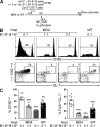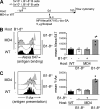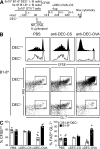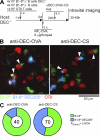A dynamic T cell-limited checkpoint regulates affinity-dependent B cell entry into the germinal center
- PMID: 21576382
- PMCID: PMC3173244
- DOI: 10.1084/jem.20102477
A dynamic T cell-limited checkpoint regulates affinity-dependent B cell entry into the germinal center
Abstract
The germinal center (GC) reaction is essential for the generation of the somatically hypermutated, high-affinity antibodies that mediate adaptive immunity. Entry into the GC is limited to a small number of B cell clones; however, the process by which this limited number of clones is selected is unclear. In this study, we demonstrate that low-affinity B cells intrinsically capable of seeding a GC reaction fail to expand and become activated in the presence of higher-affinity B cells even before GC coalescence. Live multiphoton imaging shows that selection is based on the amount of peptide-major histocompatibility complex (pMHC) presented to cognate T cells within clusters of responding B and T cells at the T-B border. We propose a model in which T cell help is restricted to the B cells with the highest amounts of pMHC, thus allowing for a dynamic affinity threshold to be imposed on antigen-binding B cells.
Figures







References
-
- Bonifaz L., Bonnyay D., Mahnke K., Rivera M., Nussenzweig M.C., Steinman R.M. 2002. Efficient targeting of protein antigen to the dendritic cell receptor DEC-205 in the steady state leads to antigen presentation on major histocompatibility complex class I products and peripheral CD8+ T cell tolerance. J. Exp. Med. 196:1627–1638 10.1084/jem.20021598 - DOI - PMC - PubMed
-
- Boscardin S.B., Hafalla J.C., Masilamani R.F., Kamphorst A.O., Zebroski H.A., Rai U., Morrot A., Zavala F., Steinman R.M., Nussenzweig R.S., Nussenzweig M.C. 2006. Antigen targeting to dendritic cells elicits long-lived T cell help for antibody responses. J. Exp. Med. 203:599–606 10.1084/jem.20051639 - DOI - PMC - PubMed
Publication types
MeSH terms
Substances
Grants and funding
LinkOut - more resources
Full Text Sources
Other Literature Sources
Miscellaneous

